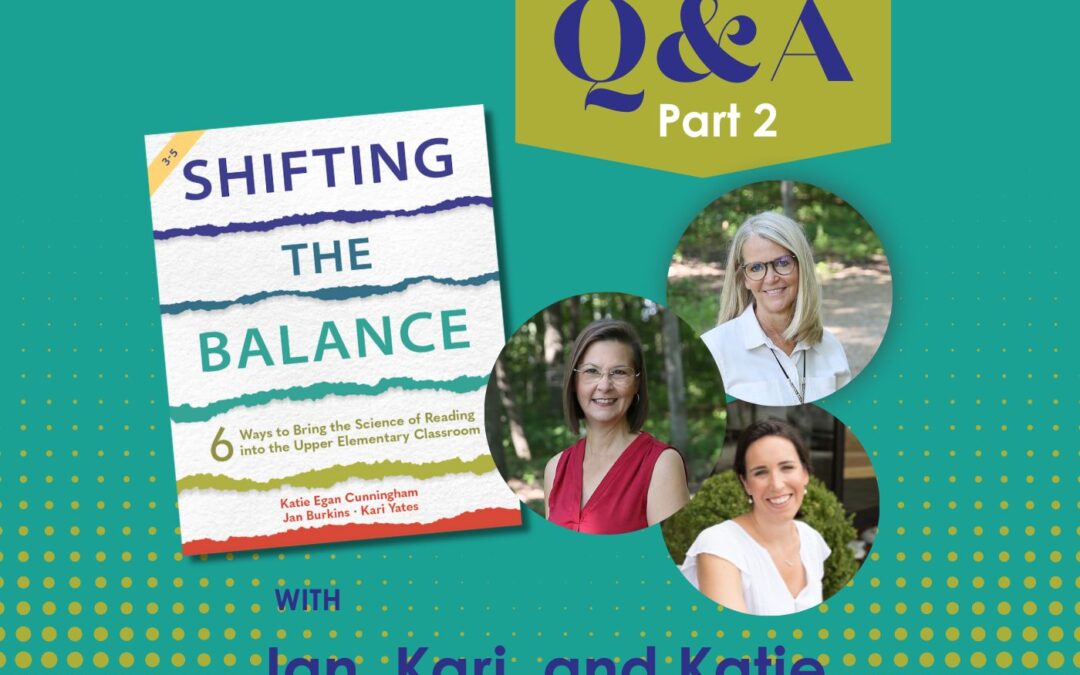Last week, we shared the first part of our two-part Q&A series about how the newest Shifting the Balance 3-5 book that we wrote with Katie Egan Cunningham came to be.
Today, we will continue to explore common questions readers have about the newest Shifting the Balance book, including specific questions about each NEW shift.
Read the full Q&A below to get to know the newest Shifting the Balance book, and read the answers to common questions related to each of the shifts.
Q: Like the first book, you’ve structured this Shifting the Balance book around six new shifts. What will readers recognize from the first book?
A: Both books emphasize simple shifts in thinking, which can initiate incremental shifts in practice that can lead to larger, transformational change. The “simple shifts” terminology is also in reference to the fact that teachers don’t have to throw everything out and start over, which leads to the perpetual pendulum swings that plague education. They can get started by making those adjustments that both honor their instructional practices that are already aligned to reading science while revising (or even eliminating) those that are not. Readers of the first book will also find the same overarching structure in each chapter, including a classroom story, common misunderstandings, science summaries, practices to reconsider, and high-leverage routines they can put in place right away.
Q: (Shift 1: Reconsidering How Knowledge Impacts Comprehension)
You write that even though we live in an age when we can “google” anything, knowledge building should be an important part of reading comprehension instruction. Can you say more about that?
A: Even though we carry around portable computers in our pockets everywhere, it turns out that the knowledge we need for reading comprehension actually has to be in our heads already. In fact, to comprehend well, we need to already understand 95% of what we are reading (citation?). This was a big aha for us in the research, and in the book, we offer ideas about how to create text sets that can allow knowledge to grow across texts. We also write about the importance of science and social studies, which tend to get short shrift instructionally. In the online class that is a companion to the book, we unpack in detail both text set development and the accompanying lesson planning.
Q: (Shift 2: Rethinking the Role of Strategy Instruction in Learning to Comprehend)
Why are reading comprehension strategies essential but not sufficient?
Q: (Shift 3: Recommitting to Vocabulary Instruction)
What are your thoughts about how to make the most of vocabulary instruction?
A: Vocabulary knowledge is a big part of reading comprehension, but vocabulary instruction sometimes gets too little attention. We’re excited about what research shows us about the need for a mix of approaches, including those on-the-fly moments where we define a word during a read-aloud, as well as more explicit instruction that helps students lock in a word’s meaning, pronunciation, and spelling. Research also points to vocabulary strategies students need to flexibly use since we certainly can’t explicitly teach every word they’ll need to know! Making the most of vocabulary instruction really means being purposeful about both implicit and explicit instruction and engaging a repertoire of science-aligned instructional moves. In the online class, we take shift 2 deeper by describing each of these instructional moves in-depth.
Q: (Shift 4: Reclaiming Word Reading Instruction)
Explicitly teaching word reading skills tends to fall off after second grade. Why do you think word reading instruction is still important in the upper elementary grades?
A: There are lots of children who just haven’t yet mastered English’s written code when they get to third grade. Covid has also complicated things because lots of children missed explicit instruction in foundational skills when they were learning from home or learning with a mask on. So, the word reading challenges today’s children have are really magnified for a lot of upper elementary teachers right now. But even after the impact of Covid has passed us, there will always be many children who need more repeated, direct, explicit instruction than others, even under the best of circumstances. In this shift, we explain the two challenges teachers have to contend with: the “Filling-Gaps” challenge of working to meet the needs of students who’ve not gotten off to as strong a start with reading and have gaps in their learning and the “Moving-Forward” challenge of helping all readers develop the skills they need for reading multisyllabic words accurately and automatically. Fortunately, time spent on word recognition development in these grade levels will inevitably support reading comprehension if word recognition is part of a comprehensive approach to literacy learning. And in the online class, we dig into instructional connections between word recognition and reading comprehension, and the instructional moves that support them both.
Q: (Shift 5: Revisiting Fluency Instruction)
What’s important for teachers to think about when it comes to fluency instruction?
A: Interestingly, the brain doesn’t really know the difference between silent reading and oral reading! Either way, the human brain has to listen to comprehend, even when we’re reading silently and “listening” inside our heads. So if children aren’t managing the demands of fluency – rate, intonation, phrasing – then what the brain hears during silent reading will cause comprehension to break down. This relationship between listening comprehension and reading comprehension doesn’t mean that it’s appropriate to ask students to read aloud one after another in front of their peers. In this shift, we offer science-aligned approaches for how to make oral reading instruction meaningful for students so they can read with accuracy and automaticity and make meaning in the process. On a really fun note, in the online class, we include some recordings of students practicing repeated readings.
Q: (Shift 6: Reimagining Independent Practice in the Literacy Classroom)
How might a teacher reimagine traditional independent reading practices?
A: Throughout the book, we draw on research that shows how becoming an active reader takes both skill and motivation. Creating a context where students become confident, capable readers is truly an important part of teaching readers of any age. What we found by studying the reading research was that if we could make space to stretch our thinking about independent reading, we could make space for a variety of more effective and science-aligned reading practices while still honoring the research that supports the power of choice. We think teachers will feel empowered by this shift to take another look at what’s working and what might need to change about independent practice for all students to meaningfully engage with a variety of texts. In the online class, we help educators move from the idea that independent reading is always a single student reading silently from a single, self-selected text to a model that is broader and more science-aligned.
Q: Where does responsive teaching come into the equation?
A: Success in the classroom will always come down to understanding the strengths and needs of individual students and drawing responsively from a toolkit of proven instructional approaches. The six new shifts we articulate in this book and take deeper in the corresponding online class will help teachers become even more responsive to their students. These shifts apply whether teachers have students who are successfully navigating the reading road as well as those educators who have students who need extra and nuanced support to become skilled readers. For most teachers, they are doing both! We know there are dedicated, intelligent, and caring teachers out there who are doing everything they can to bring readers along. But many of them just haven’t had enough support to translate reading science into classroom practice to make reading instruction both brain-friendly and engaging. This book is here to help.
Q: What’s your advice about where teachers should start as they embark on making science-aligned shifts?
A: Start by getting curious about the readers in your classroom and about reading science. Then, lean into the vulnerability it takes to make shifts in thinking and in practice. As we mentioned earlier in this Q&A blog series, teaching is both headwork and heartwork. So, we encourage teachers to give themselves and one another grace. We recommend beginning with the book that addresses the needs of the students you are most concerned with. If you teach 4th grade and have a lot of students who are having difficulty or have gaps in their reading skills, then start with the K-2 book. But if you teach upper elementary and have students who are ready for more complex texts and fluency work, then start with the 3-5 book. The books are connected in such a way that you can start with either one and read the other one as a sequel.
Keep in mind that the field will continue to move forward. And if you want to take the learning in either book even deeper, then join us for the corresponding online class–whether K-2 or 3-5. Our assumptions will continue to be challenged. It’s how we all learn and grow together to ensure all children have access to the secrets of the code and immersive experiences with texts.
❤️ Jan, Kari, and Katie




